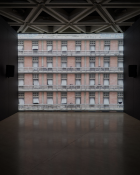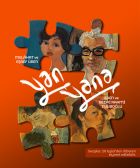And now the review of the concert at the Wigmore Hall streamed online on May 11-12. The French mezzo-soprano Marianne Crebassa and Turkish pianist Fazıl Say performed songs by Debussy, Ravel, Fauré and Duparc. Mr Say also played some solo piano pieces by Debussy and Satie, as well as two of his own compositions.
The proceedings began with Debussy’s song cycle Trois Mélodies de Paul Verlaine. In the first of the three, La mer est plus belle, Fazıl Say’s upward-sweeping arpeggios were dramatically phrased, creating a thrilling cue for Marianne Crebassa’s initial entry; from the get-go, her full-bodied mezzo voice was notable for its formidable edge. Béziers, her home town, is not far from the Spanish border, and it shows.
Fazıl Say’s ending was a gentle contrast – indeed, the duo’s endings were invariably well thought out, but most of the credit must go to him. The second song in the cycle, Le son du cor, was a model of emotional commitment on the part of Ms Crebassa: she certainly knows not just how to make the music get up and shake itself, but also how to set it prancing around the paddock. The ‘leaving-you-hanging’ ending was yet again beautifully co-ordinated, with singer and pianist raising their hands in unison at the conclusion, Ms Crebassa providing a counterpoint to Mr Say’s habitual end-of-piece wavy gestures. In both this piece and the third, L’échelonnement des haies, Fazıl Say proved himself an expert accompanist, demonstrating excellence in the fields of diplomacy, timing and coordination. Ms Crebassa’s rendition, meanwhile, had – as we had come to expect by then – lashings of vibrancy and emotional warmth.
The next item was Erik Satie’s Trois Gnossiennes – a solo performance by Fazıl Say. Though he did not overdo the pedalling on this occasion, to give him his due, he did play around with the tempi, slowing down considerably in places where he thought it necessary to inject some extra drama. The title of these pieces, however, is Gnossiennes, suggesting all that is mystic and inscrutable. The not-absolutely-necessary rubato was accompanied by exaggerated dynamic contrasts, creating an effect that I thought emotionally overcharged. Satie (with his Rosicrucian leanings) surely intended the listener to extract whatever metaphysical meaning they wished from his calm, meditative pieces without having an emotional guidebook thrust into her or his hand. Actually, all the performer need do is hold up an unsullied mirror to this enigmatic music, and let it speak for itself.
The Satie was followed by two more solo piano pieces: La cathédrale engloutie and Minstrels from Debussy’s Préludes, Book One. I am afraid I must take issue with Fazıl Say’s interpretation of the first of these pieces. It is true that Debussy himself, when performing La cathédrale engloutie, did play parts of it at speeds different from those indicated, but I am sure he did not slow down before the climax to the point where the rhythm actually became blurred, obfuscating the beat (now you see it, now you don’t). This piece is about a cathedral, let’s not forget, and cathedrals have contours that are strictly controlled.
The rhythmic irregularities in Minstrels, by contrast, are scripted. Unlike the monumental La cathédrale engloutie, this Prélude is a series of episodes in contrasting rhythms – a fact which made the rubato less of a distraction. Minstrels was better suited to Mr Say’s talent for drama than the previous piece, and thus it was a lot more fun to listen to.
Ms Crebassa then returned to the stage for Ravel’s Shéhérazade, three fragments of Orientalist fantasy. Asie, the first of the three, worked up to a real knock-me-down, drag-me-out fortissimo climax, announced by more of Mr Say’s beautifully-executed sweeping arpeggios. What power Ms Crebassa can summon when she pulls the stops out! And she is utterly convincing, too. When she says she wants to visit Asia, you don’t have the heart to tell her about the Pakistani minibus-drivers playing ‘chicken’ with oncoming lorries, the vicious red fleas in the beds of sedate Indian rest houses, or the nameless ingredients (better not to speculate) in the food you are served in Chinese chop-houses. You resolve to let her have her way and find these things out for herself. It was by no means an unmeasured performance, however: Ms Crebassa does a nice sudden diminuendo, and she also does moodiness well. Last but not least, full marks to her for not letting her intonation waver in spite of the vigorous histrionics.
In the second piece of the three, the quieter La flûte enchantée, the singer’s swayings and expressive hand and arm movements were evidence of an ability to dominate the opera stage, while the pianist served up another good ending – on this occasion the hand-waving seemed completely appropriate. L’indifférent, the third song, was quietly intense, and the sadness well captured, with some effective contrasts of tone. I found it quite moving, in fact. The applause at the end of Ravel’s Shéhérazade was surprisingly muted, however. If I had been there I would have been yelling ‘Bravo!’.
The Spanish-flavoured vocal exercise Vocalise étude en forme de habanera was Ravel’s contribution to the repertoire of pieces for performance in singing examinations. I do not expect Ms Crebassa did badly in the exam, if indeed she ever took it: her trills, in particular, were outstanding. My only regret is that Wigmorial propriety, as well as (no doubt) practicalities, constrained her from performing this flamboyant so-called ‘exercise’ in a flouncy red dress.
After the interval we heard two songs from Fauré’s four-part Mirages cycle: the first (Cygne sur l’eau) and the fourth (Danseuse). Here, Messrs Crebassa and Say were a much more sober duo than we had seen in the first half. I remarked in the programme notes that Fauré is a bit of a formalist, and I must now register my appreciation of the good taste shown by both musicians in matching their style to this new norm. The message of the current harmonious aspect between Mercury and Saturn must surely be that the acceptance of certain disciplines (Saturn) can sometimes, at least, be the key to successful communication (Mercury). Le cygne sur l’eau was thoughtful and restrained – and restraint, of course, is a quality that merits a gold star (in Saturn’s homework notebook, at least). Danseuse was likewise anything but Dionysiac: this elegant performance was proof that Ms Crebassa’s suite of moods includes a salon as well as a dance floor.
In the case of Henri Duparc’s songs, there is an extra reason for preferring a more measured approach. He was writing at a slightly earlier period than (for instance) Debussy or Ravel. The performers wisely stayed in the admittedly reactionary, but nevertheless graceful, groove they had established in the Fauré. I noticed that even at this advanced stage in the proceedings Ms Crebassa was still showing no sign of any lapse in concentration, either in Chanson triste or in Au pays où se fait la guerre. Her gradations of tone were as careful and well-judged as they had been throughout. But it was, I thought, Fazıl Say’s accompaniments that stood out in the Duparc. His timing was invariably spot-on. In this connection I would like to single out for special praise the way he brought in the repetitions of the theme in Au pays où se fait la guerre, and record the fact that my earlier strictures on the subject of rubato overuse do not apply to the ending he supplied for Chanson triste: it worked wondrously. And as for Ms Crevassa, at a sudden crescendo in this last song she advanced several paces towards the audience, showing a great deal of theatrical savvy.
And having struck that agreeable note, I will now conclude my comments on the concert by Marianne Crebassa and Fazıl Say at the Wigmore Hall. I enjoyed listening to it, and hope you did too. On Tuesday, May 12, the day I was writing this, late afternoon sunlight was streaming into a west-facing room in my Istanbul flat as I rummaged through the cupboards there, looking out my t-shirts in anticipation of increasing temperatures. And indeed, I am egging on the warmth – in the hope that spring will soon turn into a hot, virus-killing summer. (Inshallah it will be so!)
Read the online version of the latest issue of Cornucopia here.






